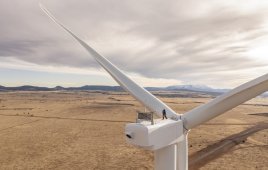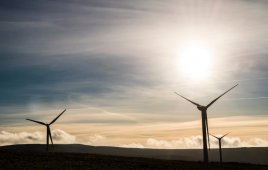Oh, so close. The 10-MW turbine has been an understandable challenge for the wind industry. Several years ago, we knew of at least three 10-MW designs that were on the drawing boards. But none materialized. Why? Stretching conventional technology to 10-MW sizes generates high stresses and handling that involves larger, heavier parts or more expensive materials, which all drive up costs.

The 9 and 9.5-MW wind turbines are part of the product portfolio intended to deliver affordable offshore wind power. Both turbines are based on the V164-8.0 MW, a machine already installed at the 258-MW Burbo Bank Extension. The company says the turbine has a firm order book of over 1.6 GW.
But MHI Vestas (Vestas is the parent company) is getting close to the 10-MW mark. The company recently announced the V164-9.5 MW based on, as you would expect, the V164-9.0 design. The company calls the 9.5 unit the most powerful serially produced wind turbine in the world. One V164-9.0 unit with massive 80-meter blades, (35 tons each) is working off the UK coast, providing company engineers with real-time data and insight to adding the next 0.5 MW.
MHI Vestas spokesman Michael Morris tells that the 9.5-MW turbine is already up and generating power, and available for sale now. “After design modifications to the prototype at Østerild, the turbine has been running at a 9.5-MW output for several months already. The company expects to receive Type Certificate by Fall 2018,” he reports.
Jens Tommerup, MHI Vestas CEO, said in a press release, “We are committed to lowering the cost of energy through innovative turbine technology. The V164-9.5 MW is built on the industry-leading V164 platform, the most powerful platform in operation.”
Company CTO Torben Larsen added that “With only minimal design changes, including a redesigned gearbox and cooling system upgrades, this turbine continues the legacy of the proven V164 platform and is available now to all MHI Vestas customers.”
The company has released a few additional details on the V164-9.5 MW turbine. For instance:
• Redesigned gearbox and cooling system are upgrades from the V164-9.0 MW
• 80-m long (87.5 yards) blades are the better part of a real football field
• Each blade weighs 35 metric tons (1,000 kg/metric ton)
• Swept area of 21,124 m2, larger than the 120-m diameter London Eye
• The nacelle measures 20-m long, 8-m wide, and 8-m high, and weighs about 390 metric tons
• Rotor and nacelle will require the tower to carry 495 metric tons
• Reduces operational and maintenance costs by letting owners run fewer, larger turbines
• MHI Vestas Offshore Wind uprated its 8-MW wind turbine to hit 9 MW during specific site conditions. The company’s prototype at Østerild broke the energy generation record for a commercially available offshore wind turbine on December 1, 2016, by producing 216,000 kWh (actual figure: 215,999.1 kWh) over a 24-hour period.
• Hub height ~105 m (Østerild prototype, 140 m)
• Max tip height, ~187 m (Østerild prototype, ~220 m)
So when’s the 10? Morris says the company does not discuss future turbine development and innovation plans. “But I can say that our innovation teams are working on concepts that will make the company competitive in the future. We’re in offshore wind for the long haul,” he reports.
Filed Under: Featured, Turbines




